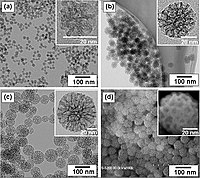
Photo from wikipedia
Nanotechnology is a rapidly evolving discipline as it has a wide variety of applications in several fields. They have been synthesized in a variety of ways. Traditional processes such as… Click to show full abstract
Nanotechnology is a rapidly evolving discipline as it has a wide variety of applications in several fields. They have been synthesized in a variety of ways. Traditional processes such as chemical and physical synthesis have limits, whether in the form of chemical contamination during synthesis operations or in subsequent applications and usage of more energy. Over the last decade, research has focused on establishing easy, nontoxic, clean, cost-effective, and environmentally friendly techniques for nanoparticle production. To achieve this goal, biological synthesis was created to close this gap. Biosynthesis of nanoparticles is a one-step process, and it is ecofriendly in nature. The metabolic activities of biological agents convert dissolved metal ions into nanometals. For biosynthesis of metal nanoparticles, various biological agents like plants, fungus, and bacteria are utilized. In this review paper, the aim is to provide a summary of contemporary research on the biosynthesis of gold nanoparticles and their applications in various domains have been discussed.
Journal Title: Bioinorganic Chemistry and Applications
Year Published: 2022
Link to full text (if available)
Share on Social Media: Sign Up to like & get
recommendations!